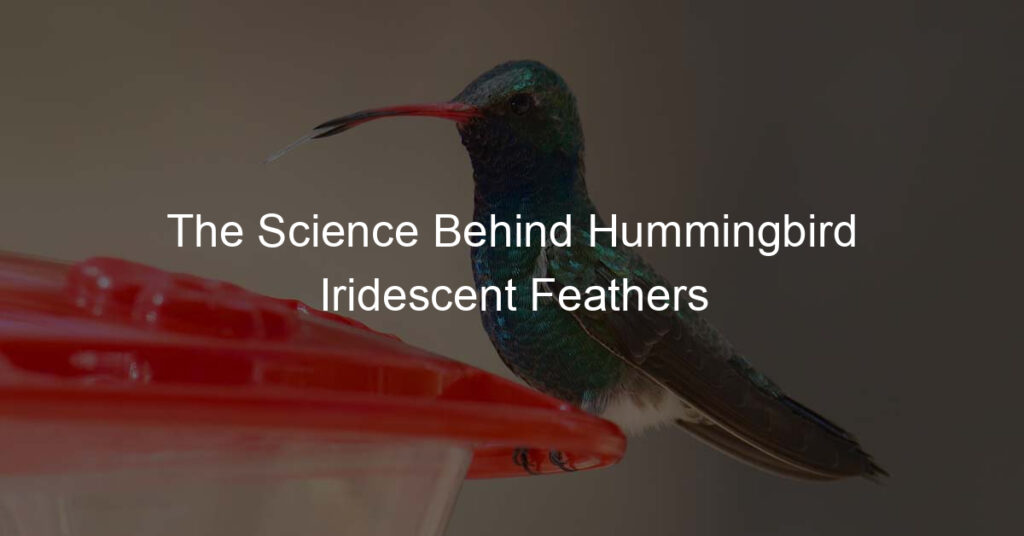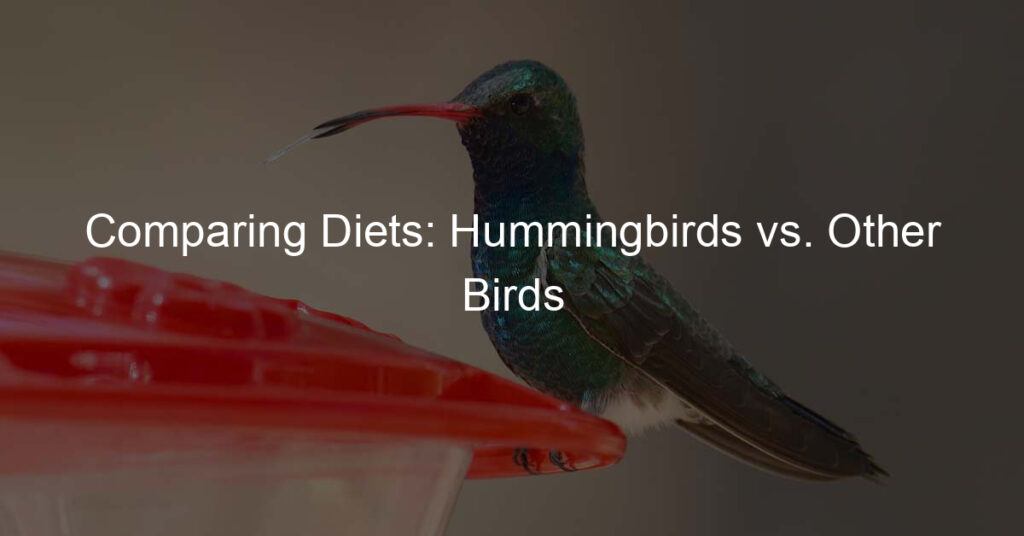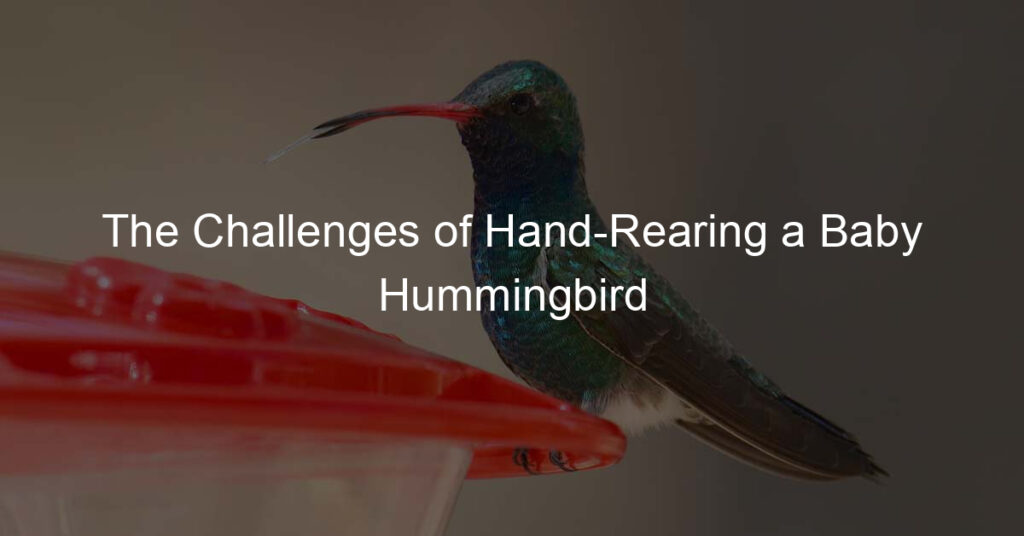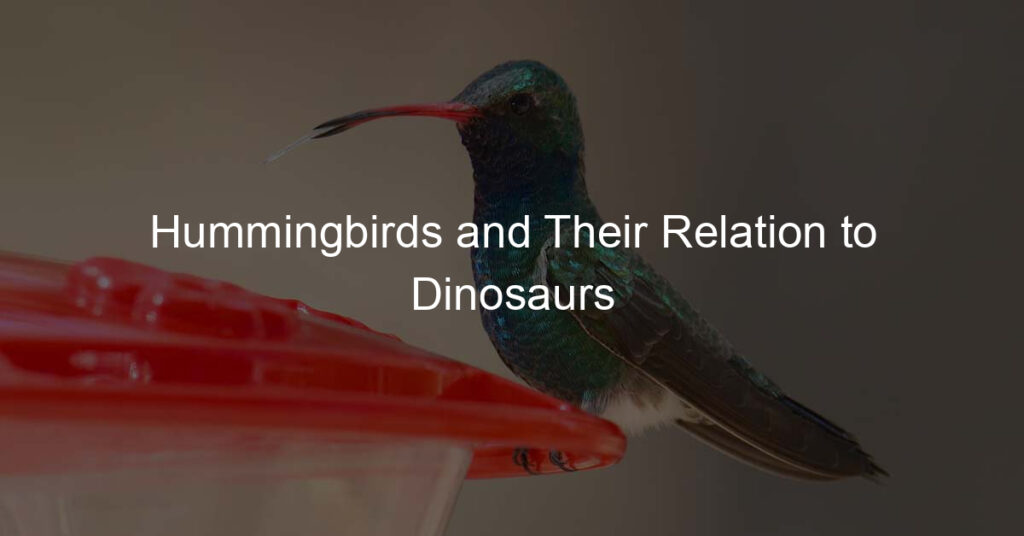Introduction to Hummingbird Feather Structure
Hummingbirds are known for their vibrant colors and rapid flight. But have you ever wondered what makes their feathers so unique? In this section, we will delve into the fascinating world of hummingbird feather structure and color.
Overview of Hummingbird Feather Structure
Hummingbird feathers, like those of other birds, are made up of a protein called keratin. However, what sets hummingbird feathers apart is their intricate structure. Each feather consists of a central shaft, or rachis, from which barbs extend. These barbs further branch out into smaller barbules.
What’s truly remarkable is the microscopic layers of platelets found in the barbules. These platelets are responsible for the iridescent colors we see in hummingbirds. The arrangement of these platelets, along with the angle of light hitting them, determines the color we perceive.
For more detailed information on the structure of bird feathers, you can visit Wikipedia’s page on feathers.
The Unique Aspects of Hummingbird Feather Color
Hummingbird feather color is not just a result of pigments, but also a phenomenon called structural coloration. This is where the color we see is influenced by the physical structure of the feather, not just the pigments present.
When light hits the feather, some of it is absorbed while the rest is reflected. The reflected light is what we see as color. Depending on the angle of viewing, the color can appear to change – a phenomenon known as iridescence.
This unique aspect of hummingbird feather color makes these birds a fascinating subject for scientists and bird lovers alike.
In the following sections, we will delve deeper into the science behind iridescent feathers, explore hummingbird coloration, and understand bird feather biology. We will also share key findings from studies on hummingbird feathers. So, stay tuned to learn more about the beauty and science of bird iridescence.
The Science Behind Iridescent Feathers
Have you ever wondered why some birds, like hummingbirds, have such colorful, shiny feathers that seem to change color as they move? This is due to a phenomenon called iridescence. Let’s explore the fascinating science behind iridescent feathers.
Iridescent Feathers Science: The Basics
Before we dive into the details, let’s start with the basics. There are two main aspects to understand: the mechanism of iridescent feathers and how light interacts with these feathers.
Understanding the Iridescent Feather Mechanism
Iridescent feathers are not like regular feathers. They have a unique structure that causes light to be refracted, or bent, in different directions. This structure is made up of microscopic layers of a protein called keratin and air. When light hits these layers, it is scattered in different directions, creating the beautiful, shimmering colors we see.
How Light Interacts with Iridescent Feathers
The colors of iridescent feathers are not due to pigments, but rather the way light interacts with the feather’s structure. When light strikes the feather, some of it is absorbed, and some is reflected. The reflected light waves interfere with each other, enhancing some colors and cancelling others out. This is why the color of the feather can appear to change when viewed from different angles.
Now that we’ve covered the basics, you should have a better understanding of the science behind iridescent feathers. In the next section, we’ll delve into more advanced concepts, including the role of microstructures in feather iridescence and how iridescence varies among bird species. 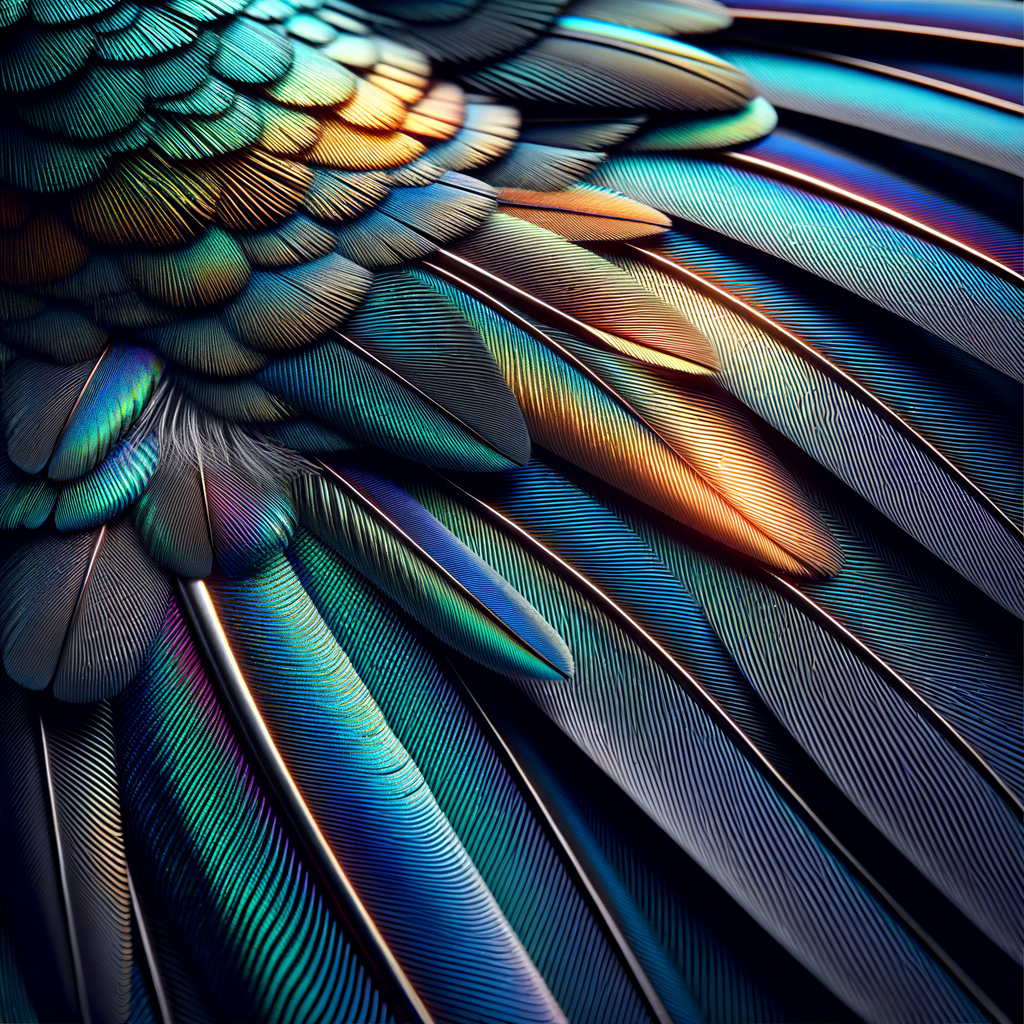
Advanced Concepts in Iridescence Feather Science
As we delve deeper into the fascinating world of iridescent feathers, we encounter two significant concepts. These are the role of microstructures in feather iridescence and the variation of iridescence among different bird species.
- The Role of Microstructures in Feather Iridescence
Microstructures play a crucial role in creating the dazzling display of colors we see in iridescent feathers. These tiny structures are found on the surface of the feathers and are responsible for the way light interacts with the feather, resulting in the iridescent effect.
These microstructures are made up of layers of keratin, a protein that is also found in our hair and nails, and air. When light hits these layers, it is reflected multiple times, creating a shimmering, color-changing effect. This phenomenon is known as thin-film interference.
- How Iridescence Varies Among Bird Species
Not all birds are created equal when it comes to iridescence. The degree and type of iridescence can vary greatly from one species to another. This variation is due to differences in the microstructures on their feathers and the way light interacts with these structures.
For example, the feathers of a hummingbird may appear green at one angle and red at another, while the feathers of a peacock may display a range of colors all at once. This variation adds to the diversity and beauty of our avian friends.
In conclusion, the science behind iridescent feathers is a complex and fascinating subject. By understanding the role of microstructures and the variation of iridescence among bird species, we can appreciate the beauty of these creatures even more.
Exploring Hummingbird Coloration
Hummingbirds are known for their vibrant and diverse coloration. In this section, we will explore the range of colors seen in hummingbird feathers and how their coloration differs from other birds.
Hummingbird Coloration: An Overview
Hummingbirds are among the most colorful birds in the world. Their feathers can display a wide array of colors, from bright reds and blues to shimmering greens and purples. Let’s dive into the fascinating world of hummingbird coloration.
1. The Range of Colors in Hummingbird Feathers
Hummingbirds are known for their strikingly vibrant feathers. These small birds can display a wide range of colors, including red, blue, green, purple, and even gold. The Ruby-throated Hummingbird, for example, is known for its bright red throat, while the Anna’s Hummingbird displays a dazzling array of green and red feathers.
2. How Hummingbird Coloration Differs from Other Birds
Unlike most birds, hummingbirds do not rely on pigments to color their feathers. Instead, they use a unique structure in their feathers that refracts light, creating a dazzling display of iridescent colors. This is why a hummingbird’s color can appear to change when viewed from different angles. This phenomenon, known as iridescence, is what sets hummingbirds apart from other birds in terms of coloration.
Understanding the coloration of hummingbirds is not just about appreciating their beauty, but also about understanding their unique biology and the science behind their stunning display of colors. In the next section, we will take a deeper dive into the role of diet and age in hummingbird coloration.
Hummingbird Coloration: A Deeper Dive
Let’s delve deeper into the fascinating world of hummingbird coloration. We’ll explore how diet and age play crucial roles in the vibrant colors of these tiny birds.
The Role of Diet in Hummingbird Coloration
Hummingbirds have a diet rich in nectar, which is a sweet liquid inside certain flowers. This diet plays a significant role in their coloration. The carotenoids, a type of pigment found in the nectar they consume, contribute to the bright colors of their feathers. For example, a diet rich in flowers with red pigments might result in a hummingbird with more vibrant red feathers.
It’s not just the nectar that affects their coloration. Hummingbirds also eat insects and spiders for protein, which can also influence their coloration. For instance, certain insects consumed by hummingbirds contain pigments that can enhance their coloration.
How Hummingbird Coloration Changes with Age
Just like humans, hummingbirds experience changes in coloration as they age. Young hummingbirds, known as juveniles, often have duller colors than adults. This is because their feathers contain less pigments. As they grow older and molt, their new feathers often come in brighter and more colorful.
Interestingly, male hummingbirds tend to become more colorful with age, while females often stay the same or even become duller. This is because males use their bright colors to attract females during the mating season.
In conclusion, the diet and age of a hummingbird play a significant role in their coloration. By understanding these factors, we can appreciate the beauty of these birds even more. For more information about hummingbirds and their fascinating coloration, check out this Wikipedia article.
Understanding Bird Feather Biology
In this section, we will delve into the fascinating world of bird feather biology. We will start with the basics, explaining how feathers develop in birds and discussing the different types of feathers and their functions.
The Basics of Bird Feather Biology
Feathers are a unique feature of birds, providing them with the ability to fly, protect themselves, and attract mates. Let’s explore the basics of bird feather biology.
How Feathers Develop in Birds
Feathers begin to develop while a bird is still an embryo inside an egg. The process starts with the formation of feather follicles, which are tiny pits in the skin. These follicles produce cells that multiply and grow into feathers. The feather’s structure and color are determined by the bird’s genetic code. For example, the vibrant colors of a hummingbird’s feathers are determined by the way the feather’s structure interacts with light.
The Different Types of Feathers and Their Functions
There are several types of feathers, each with its unique function. Here are the main types:
-
-
- Contour feathers: These are the outermost feathers that give a bird its shape and color. They also provide insulation and help with flight.
- Down feathers: These are small, fluffy feathers located beneath the contour feathers. They provide insulation to keep the bird warm.
- Flight feathers: These are long, stiff feathers located on the wings and tail. They are crucial for flight, providing lift and steering.
-
Each type of feather plays a vital role in a bird’s survival, from flight to temperature regulation to camouflage and mating displays.
Understanding bird feather biology gives us a deeper appreciation for the complexity and beauty of these creatures. In the next section, we will explore more advanced concepts in bird feather biology, including the role of genes in feather development and how feather biology influences bird behavior.
Advanced Concepts in Bird Feather Biology
As we delve deeper into the fascinating world of bird feather biology, we come across two key concepts. These are the role of genes in feather development and how feather biology influences bird behavior. Let’s explore these in detail.
-
The Role of Genes in Feather Development
Genes are like the instruction manual for every living organism. They determine everything from a bird’s eye color to the structure of its feathers. In fact, scientists have discovered that specific genes are responsible for the development and growth of feathers in birds.
For instance, a gene called ‘Sonic hedgehog’ plays a crucial role in feather formation. It helps in creating the intricate patterns we see on bird feathers. This gene is active in the areas where feathers grow, guiding the process of feather development. Read more about the ‘Sonic hedgehog’ gene here.
-
How Feather Biology Influences Bird Behavior
Feather biology is not just about how feathers look, but also about how they affect a bird’s behavior. For example, the color and pattern of a bird’s feathers can influence its mating success. Birds with brighter, more colorful feathers are often more attractive to potential mates.
Feathers also play a significant role in flight. The size, shape, and arrangement of feathers can affect a bird’s flying ability. Birds with long, narrow feathers are usually fast flyers, while those with short, broad feathers are more agile and can change direction quickly.
Feathers also help birds stay warm in cold weather and cool in hot weather. This is because feathers provide insulation, trapping air close to the bird’s body to regulate its temperature. Learn more about the functions of feathers here.
Hummingbird Feather Study: Key Findings
Our exploration into the world of hummingbird feathers has yielded some fascinating insights. We have delved into the latest research and case studies to bring you the most recent findings in this field. Let’s dive in!
-
Recent Advances in Hummingbird Feather Research
Scientists have made significant strides in understanding the unique properties of hummingbird feathers. A recent study published in the Journal of Experimental Biology revealed that the iridescent colors of hummingbird feathers are not just a result of pigmentation, but also the structure of the feathers themselves. This breakthrough has opened up new avenues for research into bio-inspired materials and color technology.
Another exciting discovery is the hummingbird’s ability to change its feather color in response to different light conditions. This phenomenon, known as iridescence, is due to the microscopic structure of the feathers, which can scatter light in different ways depending on the angle of view.
-
Case Study: The Impact of Climate Change on Hummingbird Feather Color
Climate change is having a profound impact on our planet, and hummingbirds are not immune to its effects. A recent case study conducted by the American Museum of Natural History found that rising temperatures are causing changes in the coloration of hummingbird feathers.
The study observed a shift in the color spectrum of hummingbird feathers from cooler blues and greens to warmer reds and oranges. This change is believed to be a result of the birds adapting to warmer climates. The study also noted that these changes could have significant implications for hummingbird behavior and survival, as color plays a crucial role in their mating and feeding habits.
In conclusion, the field of hummingbird feather research is constantly evolving, with new discoveries shedding light on the intricate beauty and complexity of these remarkable birds. As we continue to learn more about their unique characteristics and the challenges they face in a changing climate, we can better appreciate and protect these colorful creatures.
Conclusion: The Beauty and Science of Bird Iridescence
As we conclude our exploration of bird iridescence, particularly in hummingbirds, it’s important to reflect on the fascinating blend of beauty and science that these creatures represent. Let’s recap the science behind this phenomenon and understand why studying hummingbird feathers matters.
Recap of the Science of Bird Iridescence
The iridescence in bird feathers, especially hummingbirds, is a result of complex biological structures and light interaction. The feathers contain microscopic structures that refract light, similar to a prism, creating a dazzling display of colors. This is not due to pigments, but rather the structure of the feathers themselves. The color changes based on the angle of viewing, which is why a hummingbird may appear differently colored when it moves. Iridescence is a fascinating aspect of bird biology that continues to intrigue scientists and bird lovers alike.
Why Hummingbird Feather Study Matters
Studying the iridescence in hummingbird feathers isn’t just about appreciating their beauty. It also has significant implications for science and technology. By understanding the biological structures that create iridescence, scientists can replicate these structures in the lab. This could lead to the development of new materials and technologies, such as color-changing fabrics or improved optical devices. Furthermore, understanding bird feather biology can provide insights into bird behavior, evolution, and ecology. Therefore, the study of hummingbird feathers is a key area of research with far-reaching implications.
In conclusion, the iridescence of bird feathers, particularly hummingbirds, is a testament to the incredible intricacies of nature. It’s a perfect blend of beauty and science, a visual spectacle that serves as a gateway to understanding complex biological structures and light interaction. The study of these beautiful creatures not only enriches our appreciation for nature’s beauty but also opens up new avenues for scientific and technological advancements.

